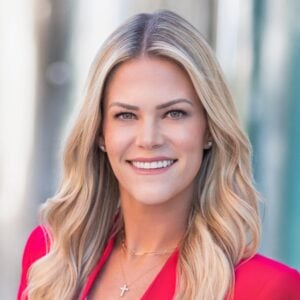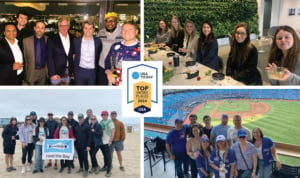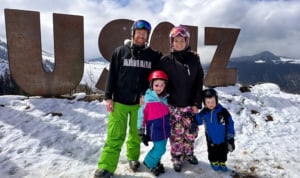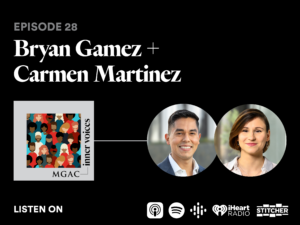MGAC Impacts: Ashley O’Connor on Designing Buildings for People, Thriving on Challenges, and the Beauty of a Big Crowd
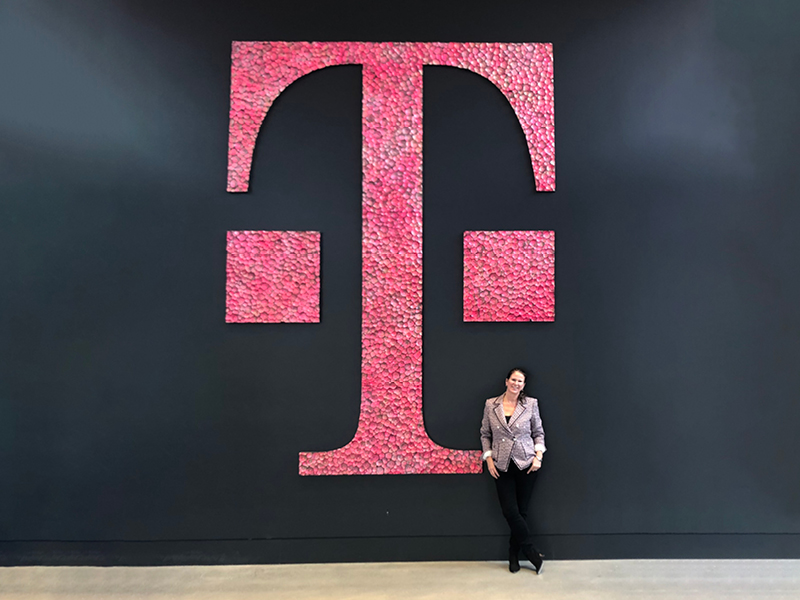
The Impact Blog is a spotlight series that highlights and celebrates the diverse employees that make MGAC tick. Beyond their day-to-day schedules, we want to know how they have a greater impact on their colleagues, their company, and the communities in which they live and work. We want to know what makes them get out of bed in the morning, what led them to their current role, and what they hope their lasting impact will be.
Today, we get to know Ashley O’Connor, Managing Director at MGAC.
—
MGAC: Hi Ashley, welcome to the blog! Tell us what you do at MGAC.
Ashley O’Connor (AO): I am a Managing Director. I work on large programs for MGAC—I do a lot of work with clients that have either big projects or big portfolios. In terms of sectors, a lot of it is corporate or institutional, including government and higher education.
MGAC: How long have you been with the company?
AO: About four years.
MGAC: And what’s keeping you busy these days?
AO: I’ve been working on T-Mobile’s Headquarters in Bellevue, Washington since 2017. They have a vision for their headquarters, a strong brand, and they really believe in what they’re doing. It’s been great helping them get there.
MGAC: Can you tell us more about that vision?
AO: The employee experience in the workplace is very important to T-Mobile. It’s not just an office where you have a desk, it’s a space that encourages collaboration, and interaction among team members, and there’s a big-picture employee experience we’re creating. They’re really centered on that. The main building will be LEED-certified. But, they are also pursuing their Fitwel certification, which is really about the employees.
MGAC: Very cool! What does the Fitwel entail?
AO: It’s about a broad view at creating office places that promote employee health and well-being. Considering how employees might get to the campus, where they might exercise, and what they might eat. So, can you ride your bike to the campus? Are there workout facilities and showers? Are there walking trails, and places to eat outside? T-Mobile has really taken it to heart. Everything on the campus is very intentionally done, and I think they have really put the employees front and center.
MGAC: Sounds like an exciting project. What else are you working on?
AO: We’re working on multiple projects with Johns Hopkins University. One is the conversion of the former Newseum building at 555 Pennsylvania Avenue. It’s a great project. It will be Johns Hopkins’ home in DC, where they will consolidate their graduate programs, offices, and multiple DC facilities. It’s an amazing, high-end building—and it’s incredibly complicated. But the team is great. The building was designed by a well-known architect, James Polshek, and is being renovated by his legacy firm Ennead, with interiors by David Rockwell. The building is being transformed from a museum into an educational and meeting space for the University. It’s really interesting to adapt this very specialized building into something else.
MGAC: And talk about a high-profile site, right on Pennsylvania Avenue! Can you tell us about the other projects with JHU?
AO: Another great project for Hopkins is the new student center on their main campus in North Baltimore. It is being designed by Bjarke Ingles; a superstar architect from Copenhagen. A great aspect of the Hopkins program is the caliber of the architecture and the complexity of their challenges and projects. These are really challenging, complex projects. To me, that makes it fun! And in the end, you have these amazing places for the people who use them.
MGAC: Nice! Let’s back up a little—what first attracted you to a job at MGAC?
AO: I have always worked around real estate. I started in management consulting for Booz Allen where I was advising clients on their real estate portfolios. And then I went on and worked for Skidmore Owings and Merrill and EDAW/AECOM. But I really wanted to work in a firm where I could do interesting projects and have a clear client focus. I was attracted to MGAC because the firm is smaller, and focuses on delivering great work.
MGAC: That’s great. Does your passion for real estate and architecture go way back? What did you want to be when you grew up?
AO: I always liked traveling. I thought at one point about being in the Foreign Service. I’ve lived and worked internationally, which furthered my interest in building, architecture, and planning aspects. I got my master’s degree in urban design. That was driven by my experience across the world, and the joy I found in the cities I have lived, visited, and worked in.
MGAC: What would that kid think about your current job today?
AO: Ha! I think that kid had no idea I would have been able to do this. As in, I never would have thought of it as an actual career path. But I’m glad that I’m able to do what I do. And the fact that it has evolved the way it did is nice. I consider myself lucky that I was able to go around the real estate world in the way I have. I’ve been lucky to be able to have seen it from all sides.
MGAC: You mentioned traveling for work. Where are some of the places you’ve been?
AO: I’ve always been based in Washington, DC, but I’ve had offices or “home desks” in other cities as well. I spent a lot of time in New York with previous roles, as well as Miami. My current work with T-Mobile takes me to Seattle often. Then there’s also London, the Middle East, India, Canada, Mexico, Spain. A lot of places!
MGAC: As you reflect on your four years with MGAC, what are some of the biggest lessons you’ve learned?
AO: I like to think I’m always learning something. If you’ve reached the point where you’re not learning anything new, you need to challenge yourself a little more!
MGAC: Good point!
AO: What we do is always evolving, especially during COVID times. How people use space, how they learn, how we build things—it’s always changing. So, if there’s anything I’ve learned, it’s more about always being open to new ideas. We should always ask why things are the way they are and how we can make them better. And there’s no set answer. I think that’s one of the things that’s hard: you have to marry what you know from experience with what’s always going to be changing.
MGAC: Right. You have to be comfortable with that change!
AO: Absolutely. If you’re delivering something for a client, you have to ask yourself, “At its core, what are we trying to accomplish? What is the essence of what we are trying to do?” And if you can keep your eye on that, you can solve all other problems.
MGAC: That’s a great perspective. Any particular challenges you’ve faced along the way?
AO: There’s that personal challenge of always wanting to do new, and more, and different. And just getting out there and having the bandwidth to do all that you want to do.
MGAC: And how do you hope taking on those new and different projects might impact your community at large?
AO: That’s kind of why I started in urban planning! Cities and places—even just a single building—can be really impactful to people. For every place I have been a part of, I hope the people living in it, working in it, and walking through it are touched by it. I hope that it’s really working for them. I look at buildings and places in a holistic way. I believe they have to be properly designed and properly built. When those two things come together, we create spaces that are lasting and able to serve the people who are part of them. Because buildings and places don’t exist without people.
MGAC: So, while you’ve been executing projects from this holistic perspective at MGAC, what about the firm would you say has made an impact on you?
AO: I think the nature of the firm. Coming from places that were ranging from big to very, very big, I appreciate having the ability to really focus on clients; to take ownership. At a big firm, it requires a lot of coordination to do anything. But because MGAC is smaller and more nimble—and, I believe, more client-focused—we’re able to get out there and just do exactly what we need to do.
MGAC: What gives you energy?
AO: Cities and crowds. People and places. That feeling of walking down a crowded city street, the dynamism of being part of a big group of people. All things that have been very difficult to experience during the pandemic!
MGAC: So true, unfortunately. What is your secret to winding down at the end of a long day?
AO: I believe in taking three minutes to empty your mind. It’s hard if there’s always something you think you need to do. Sometimes, I have to set a timer on my phone to make sure I take the time. The world we live in, there’s news coming at you all the time. Forcing yourself to put down your phone and not do anything, for me, has to be intentional. But it’s important.
MGAC: It really is. What about your secret to starting the morning off on the right foot?
AO: Coffee. I also walk the dog; I get outside for fresh air. It’s often quiet in the mornings, depending on how early it is. That’s a nice way to start the day.
MGAC: What’s a book you’ve read that has made an impact on you?
AO: Rainer Maria Rilke’s Letters to a Young Poet. I read it after I had graduated from Duke, before I went to grad school. I was living in France at the time. It’s this tiny slim set of letters, and it’s about the meaning of life. The idea of following your passion and trying to find a calling, or at least something that makes you happy.
MGAC: And what do you think your calling is? What do you hope to achieve with your work?
AO: You’d like to think that what you do makes a difference. I’d say to leave the world a better place. I think people who do what we do, in the built environment, have an opportunity to manifest that desire in a way other professions can’t, because what we do is physical.
MGAC: Now it’s time for a few rapid-fire questions. Answer with the first response that comes to mind! Sound good?
AO: Alright!
MGAC: Describe your job in 5 words or less.
AO: Missions made real. Yes, it’s MGAC’s tagline, but it really does resonate with me.
MGAC: What’s the first thing you do at work every day?
AO: If I were in the office, I would always say hi to Gia. She was our receptionist, but was recently promoted to join the procurement team as a Project Coordinator. Now that we’re not in the office, going to work means turning on the camera!
MGAC: What’s the last thing?
AO: I always say goodbye to whoever is left on the floor. If I’m at home, I turn off my computer and walk away!
MGAC: Sounds about right! What’s the weirdest thing we might find in your desk at work?
AO: I have a huge collection—like, huge—of hotel room key cards. It’s several inches high.
MGAC: That’s a new one. What can’t you leave home without?
AO: My phone. I always have an umbrella, too. That came from my time working in the UK.
MGAC: What’s your go-to lunch order?
AO: Tomato-feta soup from the Pret-A-Manger down the street. It’s delicious. And you get a roll with it, too.
MGAC: What’s the most used app on your phone?
AO: In the “before times,” I would have said the American Airlines app. But my secret shame is the Daily Mail Online. It’s such trash; it’s news that you don’t need, but it’s entertaining.
MGAC: It’s your guilty pleasure! What’s your work goal for 2021?
AO: I’m always looking for the next big problem to solve. love new projects, more projects. I would love to be able to take some of those clients and work with them in some of the cities I know and treasure overseas; so maybe more global work. I get charged by the new and exciting; the next big challenge. We have things in the works that I hope will become the next big challenge.
MGAC: That’s a good perspective. You may not know what it’s going to be, but you’re excited to take it on.
AO: Right. I’ll find it! And I hope the time will come when we’ll be able to travel more broadly. My American Airlines app isn’t getting a lot of love and attention these days!
MGAC: Where do you see yourself in 5 years?
AO: I’d like to think I could be sitting with a client on a building site in some exotic location. A big city, far away, no mask. Working through the plan for something huge and cool. I don’t know where that would be, but I’m open-minded!
